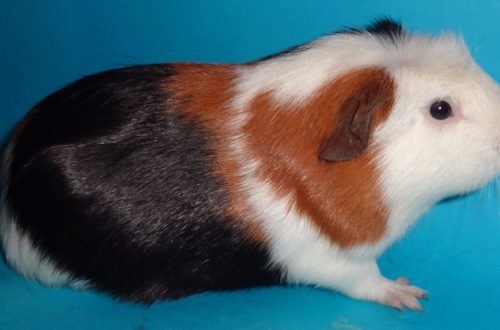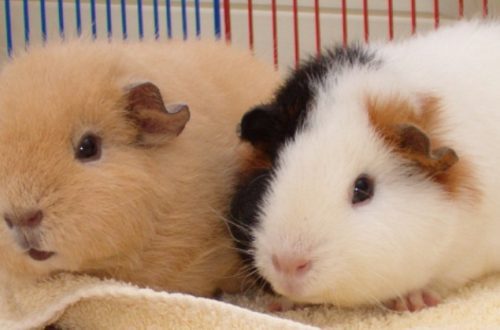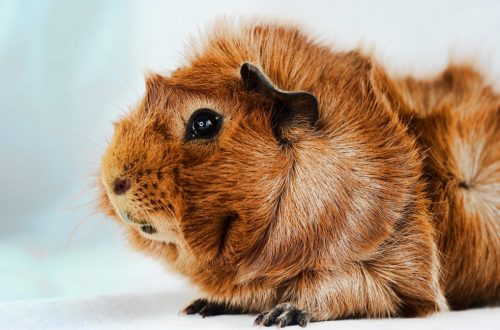
Guinea pig English Crested
The English Crested Guinea Pig is a breed that is little known in Russia, and therefore shrouded in numerous myths and erroneous judgments, sometimes contradictory and fundamentally wrong. In particular, in Runet you can find information that an English crested is an ordinary crested, just the adjective “English” stuck to it for some reason, probably because such pigs were brought to Russia from England. 🙂
And in one source, the author generally talks about the American Crested, mentioning a white rosette on his head, and calls such a pig “English Crested”.
Let’s try to sort out this confusion and find out what is the difference between the English crested from the American, from the usual crested and whether they exist at all, these differences.
The English Crested is one of the varieties of the Crested breed.
There are the following types of cresteds:
- actually crested (Crested) – a guinea pig with a characteristic rosette on its head, and the color of this rosette can be any, but different from the color of the rest of the fur coat;
- American Crested, or American White Crested, with a clear white rosette on its head;
- English Crested, guinea pigs, the color of the rosette of which completely matches the color of the whole body;
- English Colored Crested – very similar to English, but differs in the presence of several colors in color.
So, we hope that now all the difficulties with the identification of cresteds have disappeared, and you will never confuse an English crested with an American one.
In Europe and the USA, English crested dogs are widely used and are pets in many families.
The English Crested Guinea Pig is a breed that is little known in Russia, and therefore shrouded in numerous myths and erroneous judgments, sometimes contradictory and fundamentally wrong. In particular, in Runet you can find information that an English crested is an ordinary crested, just the adjective “English” stuck to it for some reason, probably because such pigs were brought to Russia from England. 🙂
And in one source, the author generally talks about the American Crested, mentioning a white rosette on his head, and calls such a pig “English Crested”.
Let’s try to sort out this confusion and find out what is the difference between the English crested from the American, from the usual crested and whether they exist at all, these differences.
The English Crested is one of the varieties of the Crested breed.
There are the following types of cresteds:
- actually crested (Crested) – a guinea pig with a characteristic rosette on its head, and the color of this rosette can be any, but different from the color of the rest of the fur coat;
- American Crested, or American White Crested, with a clear white rosette on its head;
- English Crested, guinea pigs, the color of the rosette of which completely matches the color of the whole body;
- English Colored Crested – very similar to English, but differs in the presence of several colors in color.
So, we hope that now all the difficulties with the identification of cresteds have disappeared, and you will never confuse an English crested with an American one.
In Europe and the USA, English crested dogs are widely used and are pets in many families.

English crested: maintenance and care
The English Crested, like all Crested guinea pigs, is a short-haired guinea pig with thick, short, close-lying fur. Short-haired guinea pigs are very unpretentious and do not require as much care as long-haired breeds. These guinea pigs are very clean, they take care of their fur coat on their own, without creating unnecessary trouble for their owner.
In fact, all care for a guinea pig comes down to 3 meals a day, changing the water in the drinker and cleaning the cage every 3-7 days. Well, even claws every few months will need to be cut. That’s all!
Food
English Cresteds, like other guinea pigs, are herbivores and therefore need fruits, vegetables and plenty of grass/hay in their diet. Carbohydrates and fiber are the basis of their diet.
Unlike most mammals, the body of guinea pigs (like the human body, by the way) cannot synthesize vitamin C on its own, so this vitamin must be supplied from the outside in the required amount. Modern guinea pig foods are fortified with vitamin C, so this type of food should be included in your pet’s diet. However, even when ingested with granules, most of the vitamin C is not absorbed, so it is imperative to add additional vitamin C in the form of drops to water or food or give your pet special chewable tablets for guinea pigs. Well, do not forget about cabbage, lettuce, sweet peppers and other vegetables rich in vitamin C.
Guinea pigs can, and should, be given fresh herbs, carrots, apples, tomatoes, cucumbers, strawberries, and grapes. Read more about allowed and prohibited foods in the “Nutrition” section
Always remove leftover food from the cage at the end of the day. As feeders, it is best to use heavy ceramic cups that are difficult to turn over. Twice a week, at least, these cups should be rinsed thoroughly with hot water. Constant access to clean water is vital for guinea pigs. Very convenient to use are special drip drinkers with a metal ball, which can be found in pet stores. Just do not forget to rinse such a drinker with a special brush every time you change the water, otherwise the water will quickly “bloom”.
Cell
A spacious and functional cage is a major factor in keeping a guinea pig healthy and active. When choosing a cage, pay attention to three key points:
- material from which the cell is made
- providing good ventilation (no aquariums and terrariums! Dune cages are also not suitable)
- ease of cleaning
- sufficient size. The size of the cage should be sufficient for the normal activity of the guinea pig. The generally accepted standard is 0,6 square meters, which corresponds to a cage measuring 100×60 cm. Ideally, guinea pigs need even more space. For their content, the rule applies: the more space, the better!
The place for the cage should be chosen away from cold walls and drafts, as well as away from direct sunlight. It is best to put the cage on a table or bedside table. In addition, please make sure that other animals cannot get to the pig and harm it. The cage must be thoroughly rinsed with hot water at least once a week. If necessary, you can use a safe cleaning agent. It is important to use environmentally friendly cleaning products such as vinegar or lemon. Avoid cleaning with chemicals as they can irritate the skin of guinea pigs.
More details – in the article “Guinea pig cage”
Guinea pig nails grow constantly, so every few months they need to be trimmed with special nippers, which can be purchased at a pet store.
Guinea pig teeth grow throughout their lives, so guinea pigs are constantly chewing on something to grind down their teeth. Sprigs of willow, birch or fruit trees, as well as special chewing sticks or chewing toys from a pet store, are quite suitable for this purpose.
The English Crested, like all Crested guinea pigs, is a short-haired guinea pig with thick, short, close-lying fur. Short-haired guinea pigs are very unpretentious and do not require as much care as long-haired breeds. These guinea pigs are very clean, they take care of their fur coat on their own, without creating unnecessary trouble for their owner.
In fact, all care for a guinea pig comes down to 3 meals a day, changing the water in the drinker and cleaning the cage every 3-7 days. Well, even claws every few months will need to be cut. That’s all!
Food
English Cresteds, like other guinea pigs, are herbivores and therefore need fruits, vegetables and plenty of grass/hay in their diet. Carbohydrates and fiber are the basis of their diet.
Unlike most mammals, the body of guinea pigs (like the human body, by the way) cannot synthesize vitamin C on its own, so this vitamin must be supplied from the outside in the required amount. Modern guinea pig foods are fortified with vitamin C, so this type of food should be included in your pet’s diet. However, even when ingested with granules, most of the vitamin C is not absorbed, so it is imperative to add additional vitamin C in the form of drops to water or food or give your pet special chewable tablets for guinea pigs. Well, do not forget about cabbage, lettuce, sweet peppers and other vegetables rich in vitamin C.
Guinea pigs can, and should, be given fresh herbs, carrots, apples, tomatoes, cucumbers, strawberries, and grapes. Read more about allowed and prohibited foods in the “Nutrition” section
Always remove leftover food from the cage at the end of the day. As feeders, it is best to use heavy ceramic cups that are difficult to turn over. Twice a week, at least, these cups should be rinsed thoroughly with hot water. Constant access to clean water is vital for guinea pigs. Very convenient to use are special drip drinkers with a metal ball, which can be found in pet stores. Just do not forget to rinse such a drinker with a special brush every time you change the water, otherwise the water will quickly “bloom”.
Cell
A spacious and functional cage is a major factor in keeping a guinea pig healthy and active. When choosing a cage, pay attention to three key points:
- material from which the cell is made
- providing good ventilation (no aquariums and terrariums! Dune cages are also not suitable)
- ease of cleaning
- sufficient size. The size of the cage should be sufficient for the normal activity of the guinea pig. The generally accepted standard is 0,6 square meters, which corresponds to a cage measuring 100×60 cm. Ideally, guinea pigs need even more space. For their content, the rule applies: the more space, the better!
The place for the cage should be chosen away from cold walls and drafts, as well as away from direct sunlight. It is best to put the cage on a table or bedside table. In addition, please make sure that other animals cannot get to the pig and harm it. The cage must be thoroughly rinsed with hot water at least once a week. If necessary, you can use a safe cleaning agent. It is important to use environmentally friendly cleaning products such as vinegar or lemon. Avoid cleaning with chemicals as they can irritate the skin of guinea pigs.
More details – in the article “Guinea pig cage”
Guinea pig nails grow constantly, so every few months they need to be trimmed with special nippers, which can be purchased at a pet store.
Guinea pig teeth grow throughout their lives, so guinea pigs are constantly chewing on something to grind down their teeth. Sprigs of willow, birch or fruit trees, as well as special chewing sticks or chewing toys from a pet store, are quite suitable for this purpose.

Character of the English Crested
English Cresteds are distinguished by their affectionate and good-natured character. They are quite curious, they love people, they are drawn to them, they love to be picked up and looked at or put on their knees. They will greet you with a loud nod each time. This is how they express their joy.
Guinea pigs are social creatures. Loneliness is detrimental to them. The best option is to keep guinea pigs as a couple, and as a same-sex couple (unless you plan to breed these animals). Most guinea pigs get along just fine, but there are a few things to keep in mind. Females almost always get along with each other, and you can keep two, three, and … well, in general, as much as you want. Males can also easily get along with each other, especially if they are related (father and son) or grow up together. But there are times when new males are not accepted by old ones, fights arise and defending the territory. For information on how to properly seat guinea pigs, read the article “Integrating pigs into a group of relatives”
English Cresteds are distinguished by their affectionate and good-natured character. They are quite curious, they love people, they are drawn to them, they love to be picked up and looked at or put on their knees. They will greet you with a loud nod each time. This is how they express their joy.
Guinea pigs are social creatures. Loneliness is detrimental to them. The best option is to keep guinea pigs as a couple, and as a same-sex couple (unless you plan to breed these animals). Most guinea pigs get along just fine, but there are a few things to keep in mind. Females almost always get along with each other, and you can keep two, three, and … well, in general, as much as you want. Males can also easily get along with each other, especially if they are related (father and son) or grow up together. But there are times when new males are not accepted by old ones, fights arise and defending the territory. For information on how to properly seat guinea pigs, read the article “Integrating pigs into a group of relatives”

Summing up, we can say that English Crested guinea pigs are a great option for beginner pig breeders, as well as an unpretentious, but affectionate and funny pet for children.
Summing up, we can say that English Crested guinea pigs are a great option for beginner pig breeders, as well as an unpretentious, but affectionate and funny pet for children.






